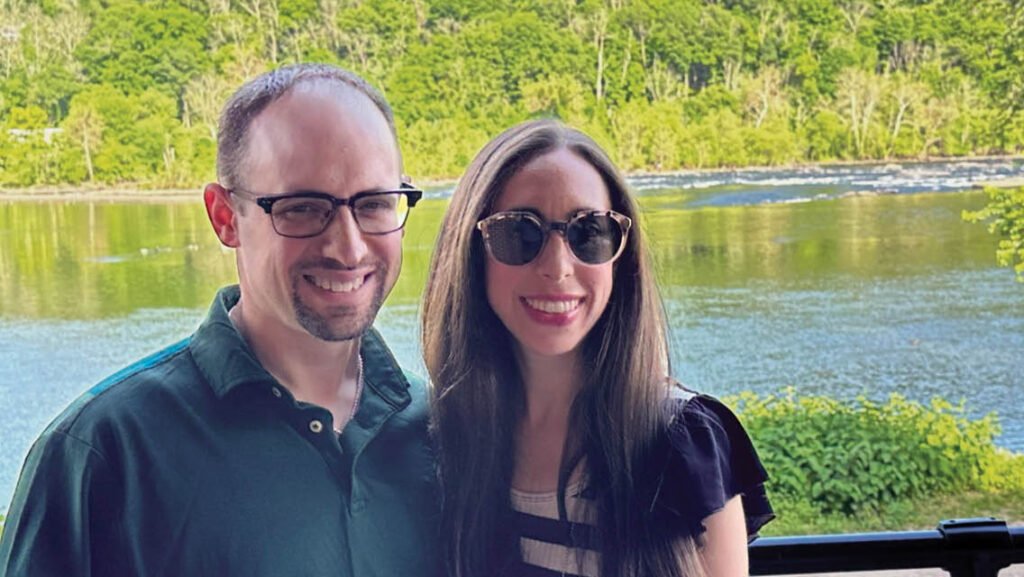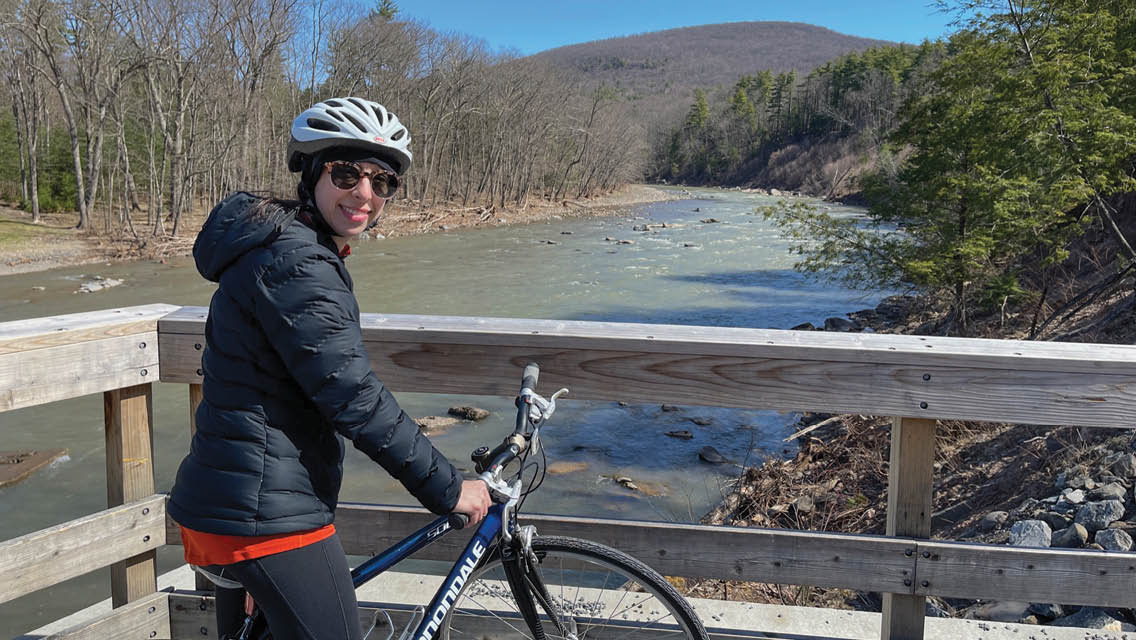With the wind brushing my face and wilderness surrounding me, I’m overwhelmed with a sense of gratitude for how far I’ve come. I feel capable and strong as my legs work against the pedals in a comforting rhythm. I’m at peace within my body despite all it’s been through.
Not long ago, I couldn’t imagine showering without taking a rest, much less riding a bike. For 13 years, I lived with a disease no doctor could name. This unknown condition made me weak, sent pain down my legs, and induced muscle twitching throughout my body. Without an explanation, I believed I’d live undiagnosed and struggle with a slowly worsening illness forever.
The turning point came in 2017, when a neurologist discovered inflammation in my nervous system. After 13 long years, I finally had an answer: multiple sclerosis (MS).
This diagnosis was far from easy to receive, but it allowed me to begin a treatment program that changed my life for the better. For the first time in years, I was hopeful for my future.
Long Road to A Diagnosis
I was only 21 when I started experiencing mysterious, debilitating symptoms, including stiffness in my legs and involuntary muscle twitching throughout my body. I couldn’t fathom why my once-healthy body was now struggling. Weeks before the symptoms began, I had been barhopping around New York City to celebrate my birthday.
An MRI of my brain revealed nonspecific lesions, which one doctor suggested might be related to MS. But the first neurologist I saw discounted the possibility.
My condition remained undiagnosed despite my efforts to find an answer. Meanwhile, my symptoms continued, varying like the seasons, and affected every day of my life.
I graduated from college, but the years following that milestone weren’t what I’d imagined they would be. Doctors’ appointments consumed every spare moment, and lab draws were part of my new weekly routine.
Some of the doctors insinuated that I was exaggerating because my disease remained invisible. Many wouldn’t think outside the box or listen deeply to my concerns.
I exhausted every branch of medicine without receiving a diagnosis. Some of the doctors insinuated that I was exaggerating because my disease remained invisible (a growing number of patients are sharing online personal stories of medical providers dismissing their symptoms as unimportant, psychosomatic, or the manifestations of hypochondria. “What Is Medical Gaslighting” for more.) Many wouldn’t think outside the box or listen deeply to my concerns. One physician advised me to go home and have a martini, as if a drink could cure what ailed me. I felt hopeless every time I left another unproductive appointment.
It was like I was trapped in a nightmare, unable to wake up. I felt disconnected from my body and unheard by professionals who were supposed to be helping me. I vacillated between worrying that my life was over and trying to control my fear and anger.
I tried to maintain a normal life while managing my symptoms and doctors’ visits. I earned a master’s degree in speech-language pathology, met and married my husband, and started a family in the suburbs of Philadelphia, where we still live today. My symptoms remained stable through the first three years of marriage and motherhood, but I began having flares after weaning my second son from breastfeeding.

My symptoms made it difficult to fulfill my role as a stay-at-home mother. I was unable to attend many family outings. Some days I could successfully food shop, though my legs would be shaky and weak by the end. A nanny helped care for our children because those duties were too much for my body to handle.
Finally, I was referred to a neurologist who listened and made sense of the nonspecific lesions on my MRI. He ordered a lumbar puncture, the results of which were consistent with MS.
When I received the diagnosis, I was flooded with concern and relief simultaneously. I cried at the thought of never regaining the abilities I’d lost, but the neurologist reassured me that my life was not over. As hard as it was to digest the news, I felt some semblance of hope.
The Right Direction
My doctor recommended an infusion of an immunosuppressant every six months to kill the cells responsible for MS. He believed the treatment could improve my symptoms but warned that it might take time for the effects to take hold.
The first few years of treatment were tough. Every symptom flared for a few months following an infusion. Weakness, profuse muscle twitching, and debilitating fatigue consumed me. I’d eventually find my way back to baseline only to be knocked back again by another infusion. My neurologist remained hopeful: “Give it some time,” he advised.
After three years of treatment, I started to notice small improvements. I could prepare dinner without my legs aching afterward. While volunteering at my children’s school, I could walk across the parking lot and through the hallways and still be able to stand in my son’s classroom.
After three years of treatment, I started to notice small improvements.
I carried chairs and bags across the field to my son’s soccer game with minimal difficulty. I was having more good days than bad, and that was a change in the right direction.
As my body regained some strength, I was inspired to start using an exercise bicycle. I knew from physical therapy in the early days of my diagnostic journey that biking was easier than walking. When I walked, my legs fatigued quickly, but on the bike, my strength lasted longer.
I hadn’t had a consistent exercise routine before I became chronically ill, and I had no intention of making it a daily practice now. But I was determined to take advantage of everything my body was now capable of doing.
In the beginning, I biked about 10 miles per hour on level-one resistance. Some days were manageable. Other days, I had to stop soon after starting because my legs were too weak.
It was hard to stick with the routine: My muscle stamina was low. But I noticed an increase in energy after exercising, which encouraged me to continue. So each day I got on my bike, and I pedaled until I needed a break.
Over weeks and months, I increased my speed, the resistance, and the length of my workouts. I built up to biking 11.5 miles daily and kept this up for a couple of years. Then one day I pushed myself a little harder and noticed I could bike farther than I realized. I was overcome with a sense of awe for how far my body had come. It was an immense improvement from where I’d been before my diagnosis.
New Trails Ahead

Although I can’t hike mountains with my family, biking rail trails enables me to be outdoors with them. We’ve biked the Ashokan Rail Trail in the Catskills; the Delaware and Hudson Rail Trail in Vermont and New York; and a trail to Bordner Cabin in Pennsylvania’s Swatara State Park — the list goes on, and it’s only just begun.
Today, my symptoms wax and wane, but I’m capable of much more than I was before. I pedal for more than an hour daily, totaling about 17 miles on a level-three resistance. Biking helps my legs build the strength and endurance they need to maintain my walking ability. It also provides cardiovascular exercise that helps keep my heart and lungs healthy.
Most importantly, biking has become my meditation and a source of stress relief. It’s boosted my self-confidence and allows me to feel strong, in control, and capable — feelings I thought I’d never experience again.
I hope to continue biking at home and outdoors with my family. Perhaps one day I’ll be strong enough to bike on hills or even up mountains. But for now, I couldn’t be more excited to live the life I have lying in front of me.
Lindsey’s Top 3 Takeaways
- Find a doctor you can trust. Their personality should mesh with yours in a way that allows for a healthy doctor–patient relationship.
- Design an exercise program that meets you where you are. The type of exercise you choose should be most compatible with your ability level.
- Focus on the better days during difficult times. Living with a chronic disease means symptoms will fluctuate. When symptoms worsen, rest and focus on the better days that lie ahead.
My Turnaround
For more real-life success stories of people who have embraced healthy behaviors and changed their lives, visit our My Turnaround department.
Tell Us Your Story! Have a transformational healthy-living tale of your own? Share it with us!
This article originally appeared as “Second Chance” in the March/April 2024 issue of Experience Life.





This Post Has 0 Comments